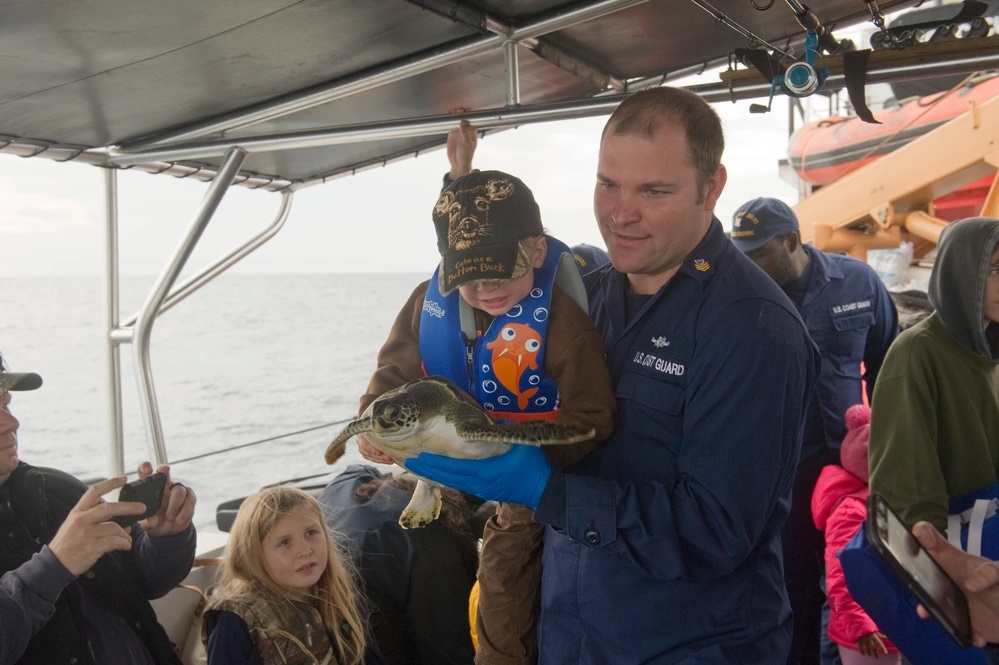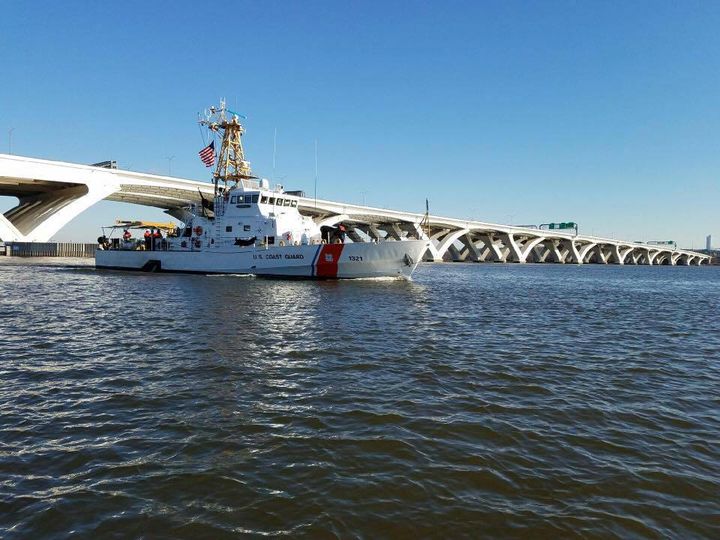 Joyful cheers rise each time a turtle slides down the brow sign into the cool Atlantic Ocean waters, just off the coast of North Carolina. Sending 130 rescued sea turtles back into the ocean would be the Coast Guard Cutter Cushing’s final mission as a commissioned U.S. vessel. For the crew, this would become a memory to cherish.
Joyful cheers rise each time a turtle slides down the brow sign into the cool Atlantic Ocean waters, just off the coast of North Carolina. Sending 130 rescued sea turtles back into the ocean would be the Coast Guard Cutter Cushing’s final mission as a commissioned U.S. vessel. For the crew, this would become a memory to cherish.
None of the crew from that 2017 mission could have imagined that in five short years – almost to the day – this patrol boat would be mortally wounded, slipping beneath the waters of the Black Sea while defending freedom and sovereignty.
Coast Guard Petty Officer 1st Class Mitchel Heavilin, a gunner’s mate assigned to Cushing when the sea turtles were sent into the Atlantic, says the cutter had a special feel. Like all 30-year-old ships, Cushing could be temperamental at times. According to Heavilin, it’s the good times aboard a cutter, as well as the hard times, that create a crew’s deep and lasting friendships. Heavilin believes that all the crews, over all those years, gave Cushing a “soul, a living breathing piece of machinery that was a second home or sanctuary for so many throughout [its] life.”
Named for an island off the coast of Portland, Maine, the Coast Guard Cutter Cushing – a 110-foot island class patrol boat – served the United States for 30 years.
After Cushing was decommissioned in 2017, it was transferred to Ukraine under the Coast Guard’s Office of International Acquisition Excess Defense Articles Program two years later. As a Ukrainian patrol boat, the Cushing received a new name and a new homeport: the Sloviansk, homeported in Odessa, in the northwest corner of the Black Sea.
However, the Sloviansk came under attack from Russian munitions in early March 2022 while defending Ukraine’s freedom and sovereignty, sinking shortly after with the entire crew.
Coast Guard Cutter Cushing – the early years
Commissioned on Coast Guard Day, Aug. 4, 1988, Cushing was one of 37 island class cutters built by Bollinger Shipyard in Lockport, La., in the later part of the 20th century. Cushing primarily supported the Coast Guard’s search and rescue, law enforcement, living marine resources, and counter drug and migrant missions in the Gulf of Mexico, Caribbean, and the Atlantic. Cushing was homeported in Alabama, Puerto Rico, and North Carolina during its Coast Guard service.
Cushing had a remarkable career. Former crewmember Shane Melvin recalls that operations “never stopped”. During the 1990s, Cushing and its crew took part in multiple humanitarian and military operations. In 1994, the Cushing was among the 55 cutters that responded to one of the Coast Guard’s largest peacetime missions in support of Operation Able Manner and Operation Able Vigil. These counter mass migration operations rescued and repatriated more than 63,000 Haitian and Cuban migrants.
Cushing also supported Operation Uphold Democracy following a military coup in Haiti. Melvin recalls these operations as being chaotic and impactful – sometimes with gruesome visuals as he and his crew rescued some people from the water and recovered some who looked as though they had seen war first-hand.
Cushing eventually transferred to North Carolina, and its mission focus changed to fisheries enforcement, marine life protection, and search and rescue.
Decommissioning the Cushing
Lt. Cmdr. Mario Gil served as Cushing’s final Coast Guard commanding officer. He was excited to fill that role.
“This was my first command of a cutter,” Gil said. “I heard great things about the cutter, the crew, the mission, as well as serving D5 in North Carolina.”
His first time getting underway with his new cutter and crew was in support of Sector North Carolina fisheries. Gil says he was “very impressed with the crew and how much pride they had for Cushing. They really took care of that 30-year-old cutter. They were so proud to be a part of the crew.”
“[Cushing] was special to us,” Heavilin said. “As a crew, together, we served D5 through so many different missions. But what made our time serving together special, was sharing our life together – the personal events.” 
Crewmembers aboard a cutter are an extremely close-knit family. The Cushing was home as they baptized crewmates’ children in the ship’s bell, weathered hurricanes, celebrated weddings, and held ceremonies welcoming permanent cuttermen to the fold once they earned their insignia.
“Experiencing growth with the entire crew – the chiefs coming into their own, junior officers becoming leaders and taking their own commands,” Heavilin said, helped give the Cushing a soulful feel. All the small moments, over time, gave the crew the sense that they – and the Cushing – were part of something special. “Boatswain’s mates learning to drive a boat earning their coxswain pin; engineers earning deep respect proving themselves in shipboard casualties. Our independent enlisted ratings – the cooks, the gunner’s mate, the electrician’s mate – proving their salt.”
In 2017 the Cushing retired from Coast Guard life and traveled to the Coast Guard Yard in Baltimore for storage. In September 2018, Ukraine was selected to receive former Coast Guard Cutters Cushing and Drummond through the Navy International Programs Office. The transfer was facilitated through the Excess Defense Articles Program of the Coast Guard’s Office of International Acquisition.
For Heavilin – whose wife is Ukrainian and has family in Odessa – it seemed fitting that his former cutter would begin a new life in Ukraine. It was special to his family when they found out “Cushing’s next chapter was going to be serving there.”
The cutters were brought out of storage, received maintenance and upgrades, and a Coast Guard transition team assisted and trained the Ukrainian navy crews on how to operate their new ships. Once the transfer was complete and the new crews were trained, Cushing and Drummond – now Sloviansk and Starobilsk – arrived in Ukraine by cargo ship in October 2019.
The Coast Guard has transferred five island class patrol boats to Ukraine so far through an Excess Defense Article (EDA) process. Other patrol boats have been transferred to Pakistan, Georgia, and Costa Rica. Each transfer saves the Coast Guard remediation and disposal costs, while building and solidifying international partnerships to foster greater global maritime security. One of the United States’ primary goals in this transfer was to help equip Ukraine with the means to protect their national sovereignty.
The Cushing will live on through memories of the hundreds of Coast Guard members who served aboard, through the memories of the families who enjoyed family cruises, and through the memories of the families of the lost crew of the Sloviansk. For Heavilin and his family, the connection of Cushing/Sloviansk remains strong, the sinking that much more impactful uniting the family on opposite sides of the world. For now, the Starobilsk – Sloviansk's sister ship that is also homeported in Odessa - continues to fight for Ukraine’s sovereignty.